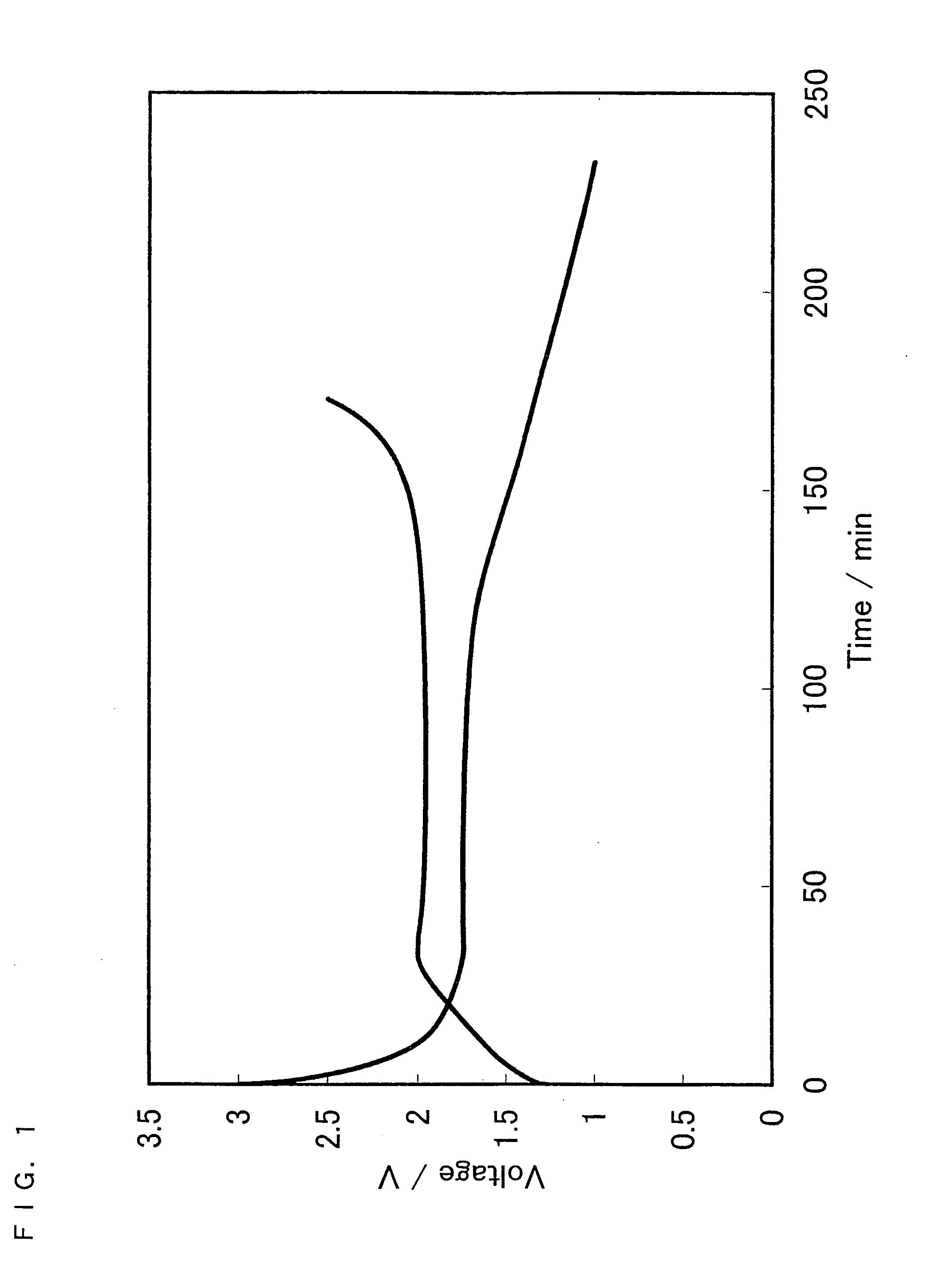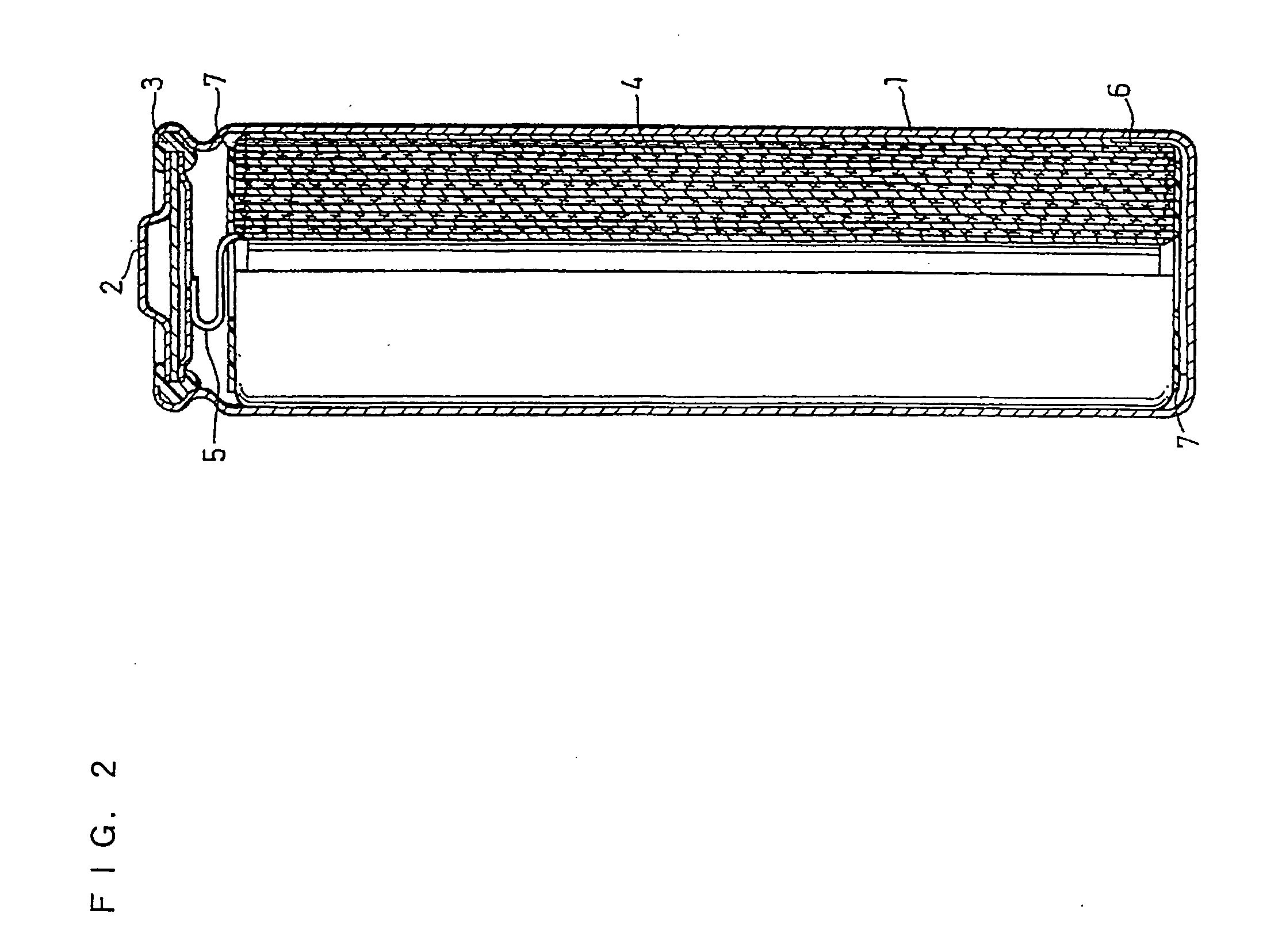Active material, manufacturing method thereof, and non-aqueous electrolyte secondary battery including the active material
a technology of active materials and manufacturing methods, applied in the direction of vanadium compounds, cell components, nickel compounds, etc., can solve the problems of low electron conductivity of titanium oxide useful for the active material disclosed in the above patent publication documents, significant decrease in battery capacity per unit volume, and insufficient mixing of conductive auxiliary agents, etc., to achieve high conductivity and high capacity
- Summary
- Abstract
- Description
- Claims
- Application Information
AI Technical Summary
Benefits of technology
Problems solved by technology
Method used
Image
Examples
experimental example 1
[0051] Titanium dioxide TiO2 has a resistivity of 1×1014 Ωcm and is almost an insulator. However, when an electrode obtained by adding sufficient amounts of a conductive auxiliary agent and a binder to the titanium dioxide is used, a battery which can discharge with a discharge potential of about 1.7V relative to Li metal can be obtained. For example, when LiCoO2 is used for a positive electrode, and TiO2 is used for a negative electrode, a lithium ion battery with 2V class can be formed.
[0052] However, due to a low conductivity of TiO2, particles of TiO2 have to be made finer, and further, a significant amount of the conductive auxiliary agent will be necessary. These factors would lead to a battery with a low energy capacity and high cost. Also, when titanium dioxide is used for the positive electrode and Li metal is used for the negative electrode, a lithium battery with 1.7V can be formed. However, the above mentioned problems still remain. Thus, in this experimental example, a...
experimental example 2
[0062] White titanium dioxide TiO2 in powder was put into a quartz reaction tube, and heated to 700° C. under a nitrogen gas atmosphere. Then, ammonia gas was flowed into the reaction tube with a flow rate of 300 ml / min while a nitrogen gas was flowed into the reaction tube with a flow rate of 50 ml / min, to react for 28 hours, to obtain a nitrogen oxide. After the reaction, since the obtained nitrogen oxide was sintered, the nitrogen oxide was ground in water by using a ball mill.
[0063] Further, the nitrogen oxide after the grinding was put into the quartz tube with methyl ethyl ketone, and heated under a nitrogen atmosphere at 300° C. for 20 minutes, and subjected to a quick cooling to obtain an active material 4 according to the present invention (TiO1.0N1.0). The volume resistivity of the active material thus obtained was measured as described above, and it was revealed that the volume resistivity was 1.0 Ωcm.
[0064] Further, white titanium dioxide TiO2 in powder was put into a ...
experimental example 3
[0070] Based on the fact that an active material according to the present invention increases a conductivity and a reduction in an amount of a conductive auxiliary agent can be expected when a battery is formed by using such active material, the active material obtained in Experimental Example 1 was used to compare capacities based on decreases of the conductive auxiliary agent, to evaluate a reduction in an amount of the conductive auxiliary agent. The results are shown in Table 2.
[0071] As for the evaluations, the measurement method of the above electrochemical properties was conducted by varying amounts of acetylene black as the conductive auxiliary agent. As for discharging capacity, comparative values relative to the value (set as 100) of capacity when the active material 1 were used and 10 parts by weight of the conductive auxiliary agent was added, are shown.
TABLE 2Amount of AcetyleneDischarge CapacityBlack [%][%]Active Material 110100(TiO1.7N0.3)Active Material 15100(TiO1...
PUM
| Property | Measurement | Unit |
|---|---|---|
| resistivity | aaaaa | aaaaa |
| temperature | aaaaa | aaaaa |
| temperature | aaaaa | aaaaa |
Abstract
Description
Claims
Application Information
 Login to View More
Login to View More - R&D
- Intellectual Property
- Life Sciences
- Materials
- Tech Scout
- Unparalleled Data Quality
- Higher Quality Content
- 60% Fewer Hallucinations
Browse by: Latest US Patents, China's latest patents, Technical Efficacy Thesaurus, Application Domain, Technology Topic, Popular Technical Reports.
© 2025 PatSnap. All rights reserved.Legal|Privacy policy|Modern Slavery Act Transparency Statement|Sitemap|About US| Contact US: help@patsnap.com



